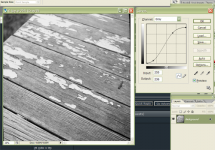trittium
Well-known
I have a photoshop process I use. If you look at vintage prints they are usually high contrast with no true whites, or low contrast.
This is what I usually do in photoshop to create a high contrast with no true whites effect.
auto contrast and levels
create and "S" curve in levels
bring the white down vertically
bang, it's done
For low contrast, make an inverse "S" curve
bam, it's done
here's an example

This is what I usually do in photoshop to create a high contrast with no true whites effect.
auto contrast and levels
create and "S" curve in levels
bring the white down vertically
bang, it's done
For low contrast, make an inverse "S" curve
bam, it's done
here's an example

Attachments
Last edited:



